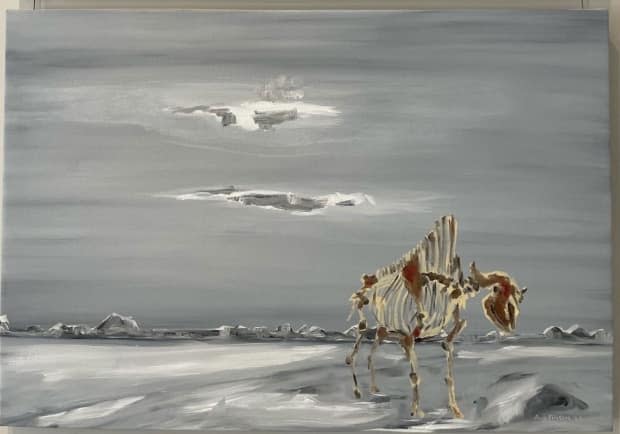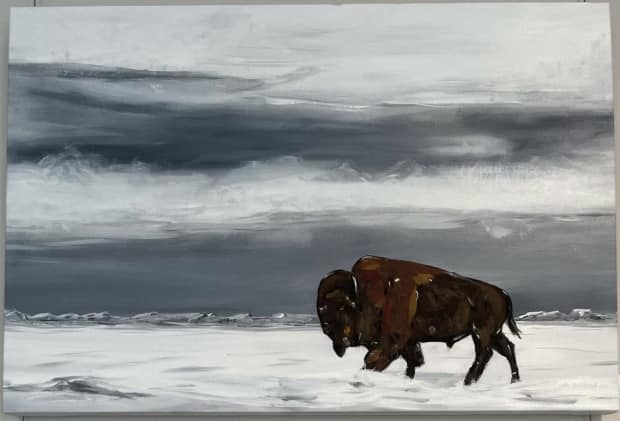Adrian Stimson's bison paintings force viewers to reckon with Canada's colonial history

A solitary bison walks the snow-covered Prairie plains, swathed in rich colours of red and dark brown, the only sign of life in an otherwise barren landscape.
Variations of this image appear over and over again in Alberta Indigenous artist Adrian Stimson's first solo European exhibit, which opened in London, England, on May 16.
Stimson said he hoped his collection, entitled Manifest Buffalo: A Bison Dream, would create a space for people to engage in conversations about Canada's dark history with Indigenous people.
The title of the exhibit is a nod to "manifest destiny," the 19th-century cultural belief that the North American settlers were destined to colonize the continent.

"As human beings, we all have to get along. But that doesn't mean that we should forget what happened, because when we forget what happens … it will continue to happen," said the 58-year-old Stimson, a member of the Siksika First Nation, who spoke to CBC on the night of the opening.
In 36 paintings created especially for the exhibition, Stimson reimagines the bison in a variety of scenes: sharing the canvas with a nuclear explosion; fenced in by a pipeline; and a calf playfully leaping through the air, an oil rig in the background.

The juxtaposition of this centuries-old icon of the Prairies roaming next to modern-day items such as an airplane was not lost on art fan Adam Heaton, who visited the exhibit on opening night.
"There's a past, present and future theme going on here, but you're not quite sure what the future is, and there's an inherent tension in that," said Heaton.
'This is something different'
Housed in a small gallery at Gurr Johns, an art advisory and appraisal group, Stimson's collection is a welcome change in genre from the works of Old Masters that had adorned the walls of the space just a week before, said senior director Spencer Ewen.
"This is something different," Ewen said, "but equally valid and equally relevant."

He reflected on the significance of an Indigenous voice having a platform on the historic Pall Mall, "the bastion of traditional art," which was the centre of London's fine art scene in the early 19th century.
Once home to the Royal Academy, the National Gallery and Christie's auction house, the artists who were permitted to develop and showcase their work here were white, European men.
Stimson, who is not only Indigenous but has a gender-bending alter ego named Buffalo Boy, provides a strong contrast.

Stimson's solo European debut was attended by Jonathan Sauvé, the head of public diplomacy for the High Commission of Canada in the United Kingdom, who thanked Stimson for bringing his art to Britain.
"Canada has a lot of work to do … but we truly believe that arts and culture are probably the best way to advance Indigenous reconciliation and expression," said Sauvé.
Stimson, whose Blackfoot name is Little Brown Boy, began painting in 1999, after he left his role as a tribal councillor for his First Nation. He considers himself to be an interdisciplinary artist, and his sculpture, photography and performances have been presented across Canada and internationally.
This is not the first time Stimson's reimaginings of the bison have caught the attention of the London art scene. In 2016, two of his paintings were purchased by the British Museum for its Blackfoot collection.
The role of the bison
The historical and cultural significance of the bison to First Nations is a major part of why the animal features so prominently in his dossier, Stimson said.

Bison was a source of food and clothing as well as a fixture of Siksika spirituality, among other purposes, that was almost entirely wiped out by the fur trade, as detailed in George Colpitts's 2014 book Pemmican Empire: Food, Trade and the Last Bison Hunts in the North American Plains, 1780–1882.
"Every time I paint a bison, it's a memory of one of those slaughtered," said Stimson.
"At that time of the slaughter, I believe that that energy, those particles, were released into the universe. And I believe that it still exists in and around us. So as an artist, I get the pleasure and the privilege of being able to sort of reach into that ether and sort of grab that energy, bring it into myself and create the work."
Siksika Nation's relationship with the Crown
At the exhibit opening, Stimson welcomed attendees in the Blackfoot language and wore his traditional headdress as a means of bringing his ancestors and descendants into the room, he said.
He added that donning his regalia also reaffirmed the Siksika Nation's special relationship with the Crown, one that was cemented in legislation by the signing of a treaty in 1877, which established an area of land for the tribes, promised annual payments from the Queen and ensured continued hunting and trapping rights in exchange for the Siksika ceding their rights to their traditional territory.

Stimson maintained that this "nation-to-nation relationship" will remain strong as long as "the sun shines, grass grows and river flows."
Manifest Buffalo: A Bison Dream is opening the same week that other members of Stimson's nation are travelling to a museum in Exeter, in southwestern England, to repatriate several items belonging to Crowfoot, a late-nineteenth-century Blackfoot leader.
Stimson himself was invited to participate. As a former president of the First Nations Confederacy Culture Education Centres, Stimson said he "forwarded a lot of legislation" on the repatriation of historical artifacts.
The artist said that in "bringing the herd" to London, the bison has once again become a means of survival, stirring painful memories of colonization and teaching the world about the resilience of his people.

 Yahoo Movies
Yahoo Movies 
